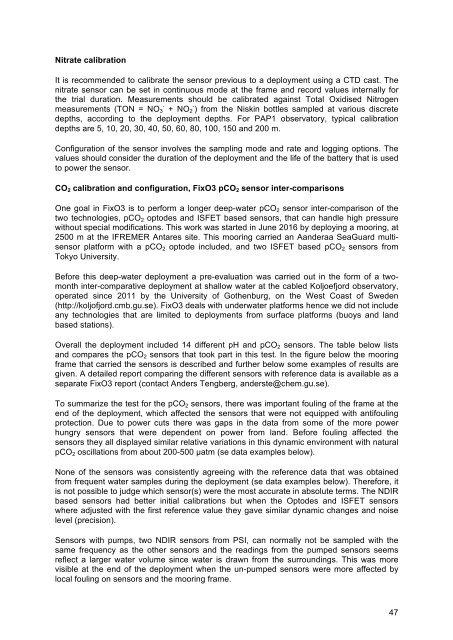Handbook of best practices
Handbook%20of%20best%20practices
Handbook%20of%20best%20practices
Create successful ePaper yourself
Turn your PDF publications into a flip-book with our unique Google optimized e-Paper software.
Nitrate calibration<br />
It is recommended to calibrate the sensor previous to a deployment using a CTD cast. The<br />
nitrate sensor can be set in continuous mode at the frame and record values internally for<br />
the trial duration. Measurements should be calibrated against Total Oxidised Nitrogen<br />
-<br />
measurements (TON = NO 3 + NO - 2 ) from the Niskin bottles sampled at various discrete<br />
depths, according to the deployment depths. For PAP1 observatory, typical calibration<br />
depths are 5, 10, 20, 30, 40, 50, 60, 80, 100, 150 and 200 m.<br />
Configuration <strong>of</strong> the sensor involves the sampling mode and rate and logging options. The<br />
values should consider the duration <strong>of</strong> the deployment and the life <strong>of</strong> the battery that is used<br />
to power the sensor.<br />
CO 2 calibration and configuration, FixO3 pCO 2 sensor inter-comparisons<br />
One goal in FixO3 is to perform a longer deep-water pCO 2 sensor inter-comparison <strong>of</strong> the<br />
two technologies, pCO 2 optodes and ISFET based sensors, that can handle high pressure<br />
without special modifications. This work was started in June 2016 by deploying a mooring, at<br />
2500 m at the IFREMER Antares site. This mooring carried an Aanderaa SeaGuard multisensor<br />
platform with a pCO 2 optode included, and two ISFET based pCO 2 sensors from<br />
Tokyo University.<br />
Before this deep-water deployment a pre-evaluation was carried out in the form <strong>of</strong> a twomonth<br />
inter-comparative deployment at shallow water at the cabled Koljoefjord observatory,<br />
operated since 2011 by the University <strong>of</strong> Gothenburg, on the West Coast <strong>of</strong> Sweden<br />
(http://kolj<strong>of</strong>jord.cmb.gu.se). FixO3 deals with underwater platforms hence we did not include<br />
any technologies that are limited to deployments from surface platforms (buoys and land<br />
based stations).<br />
Overall the deployment included 14 different pH and pCO 2 sensors. The table below lists<br />
and compares the pCO 2 sensors that took part in this test. In the figure below the mooring<br />
frame that carried the sensors is described and further below some examples <strong>of</strong> results are<br />
given. A detailed report comparing the different sensors with reference data is available as a<br />
separate FixO3 report (contact Anders Tengberg, anderste@chem.gu.se).<br />
To summarize the test for the pCO 2 sensors, there was important fouling <strong>of</strong> the frame at the<br />
end <strong>of</strong> the deployment, which affected the sensors that were not equipped with antifouling<br />
protection. Due to power cuts there was gaps in the data from some <strong>of</strong> the more power<br />
hungry sensors that were dependent on power from land. Before fouling affected the<br />
sensors they all displayed similar relative variations in this dynamic environment with natural<br />
pCO 2 oscillations from about 200-500 μatm (se data examples below).<br />
None <strong>of</strong> the sensors was consistently agreeing with the reference data that was obtained<br />
from frequent water samples during the deployment (se data examples below). Therefore, it<br />
is not possible to judge which sensor(s) were the most accurate in absolute terms. The NDIR<br />
based sensors had better initial calibrations but when the Optodes and ISFET sensors<br />
where adjusted with the first reference value they gave similar dynamic changes and noise<br />
level (precision).<br />
Sensors with pumps, two NDIR sensors from PSI, can normally not be sampled with the<br />
same frequency as the other sensors and the readings from the pumped sensors seems<br />
reflect a larger water volume since water is drawn from the surroundings. This was more<br />
visible at the end <strong>of</strong> the deployment when the un-pumped sensors were more affected by<br />
local fouling on sensors and the mooring frame.<br />
47


